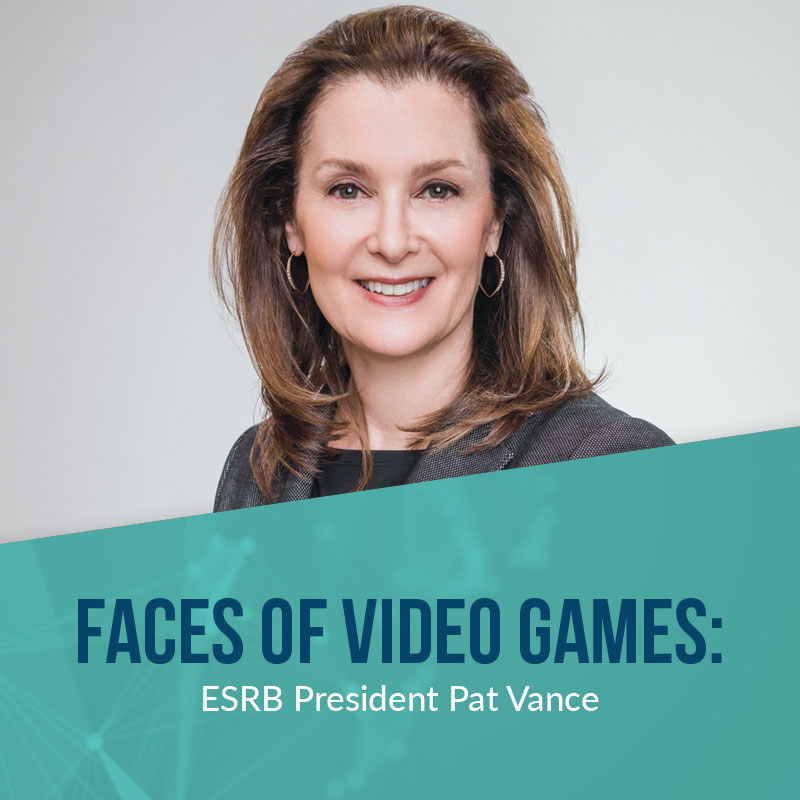
Q1. For the uninitiated, could you start by telling us about the Entertainment Software Rating Board and its role in the video game industry?
Sure. ESRB is the non-profit, self-regulatory body for the video game industry that empowers consumers, especially parents, with guidance that allows them to make informed decisions about the age-appropriateness and suitability of video games and apps while making sure the video game industry responsibly markets its products.
Q2. Is there anything you’d want everyone to better understand about ESRB and how it operates?
One thing we rarely have a chance to discuss is how much ESRB does outside of ratings. While ratings are, and always will be, our bread and butter, we have other responsibilities we take equally seriously.
For example, part of our self-regulatory role also extends to enforcing industry-adopted advertising guidelines to ensure that ratings are accurately and prominently displayed in advertisements and those ads are appropriately targeted. In other words, we make sure that commercials for M-rated games don’t appear during TV programs that are popular with children, and those that do appear on TV include content appropriate for a general audience.
We also work with some of the country’s biggest retailers to help enforce their in-store policies prohibiting the sale of M-rated games to anyone under the age of 17 without a parent present.
Over the years we’ve continued to expand ESRB Privacy Certified (EPC), a full-service program that helps ensure that member companies employ best practices when collecting personal information on their websites and mobile apps. From COPPA Safe Harbor protection to expert advice on compliance with the General Data Protection Regulation (GDPR) in Europe, EPC is one of the leading privacy certification providers for our industry and beyond.
Like I said, our core mission revolves around informing parents about the games their kids want to play, but our activities go far beyond that.
Q3. The number of video games published each year is enormous, how does the ESRB rate so many titles and ensure parents always have access to accurate, high-quality information?
Thankfully, we foresaw the challenge of scaling our rating system to handle the onslaught of mobile and digital games coming into the market many years ago. In 2012, after having tested a similar service with Verizon and Microsoft for mobile apps, we launched a no-fee digital rating service for online and console downloadable games. This automated solution not only allowed publishers and developers to obtain rating assignments quickly, it eliminated their cost, which was a huge help to independent developers looking to publish their digital titles on consoles. By automating the rating assignment based on a developer’s answers to a multiple-choice questionnaire, we shifted our internal resources from reviewing content prior to a game’s release to directly following it in order to make sure that the ratings were being assigned accurately.
That being said, in a digital and mobile world, no rating authority is an island. Global storefronts needed a streamlined rating service that could assign ratings… at once… from around the globe. So, in 2014 ESRB spearheaded the founding of the International Age Rating Coalition (IARC) with several other international rating authorities to develop a streamlined fully automated rating solution that incorporates the unique criteria and ratings for different regions around the world and costs developers nothing to use. Starting with PEGI in Europe, USK in Germany and ClassInd in Brazil, IARC has welcomed additional rating authorities into the fold including the Australian Classification Board and Republic of Korea’s GRAC, and added a legally compliant rating for Russia. Generic IARC ratings are assigned in all remaining territories.
Today, Google Play, the Nintendo eShop, the PlayStation Store (North America for now; coming soon to Europe), the Microsoft Store for Windows and Xbox, and the Oculus Store have all deployed the IARC rating system. More storefronts are coming on-board in the near future.
Q4. What was it like spearheading the creation of IARC? What did that involve?
To say the least, IARC was ambitious. The concept was initially met with lots of skepticism in the international community of rating agencies. Moreover, many rating agencies outside of the U.S. are departments of the government with laws that regulate how ratings are assigned and by whom. But I saw an existential threat to our organization if IARC didn’t happen. In other words, if we didn’t do something to better serve the digital and mobile games market, the ESRB would over time wither and die, as would other rating agencies even if they didn’t yet realize it. I knew IARC was the right thing to do, it was just a matter of time.
In addition to the efforts to sign up other rating agencies, we had to build a best-of-class enterprise solution that the big tech companies would feel comfortable implementing. I spent a good deal of time talking to global storefronts to better understand their needs so we could essentially build the system to their specs. We hired a highly-skilled team of engineers and went to work. These guys really rocked. Prior to ESRB, I spent almost two decades developing and launching interactive media products, so that experience certainly came in handy. A good challenge never stopped me before, why should it now!? And that undergraduate degree in International Relations sure did come in handy establishing a global organization!
Of course, the real game changer for IARC came when Google licensed the system. The launch of IARC in the Google Play store in 2015 was the ultimate proof that the system actually worked and that it could scale. Within the first few hours of Google turning the system on, we had assigned more ratings than all of the combined ratings assigned by the ESRB since its formation. IARC was no longer a utopic vision of what an ideal rating system could be. It was now the path to ensuring our relevance and our future.
Q5. 86% of parents of children who play video games are aware of ESRB ratings and of them 74% regularly check the ratings before making a purchase. Why do you think parents have such confidence in the ESRB?
We’re now in our 25th year. We’ve earned parents’ trust by consistently delivering ratings they find accurate and reliable. Don’t forget every ad for a game in the last 25 years displays our ratings, as do the physical boxes of games sold in stores and online. We’ve worked to make sure they’re hard to miss! We could not have achieved that level of awareness and use without the tremendous support we have received across the industry, including publishers, console manufacturers and retailers.
Additionally, we’ve spent a lot of time listening to parents and evolving the system based on what we learn from them. Every year we conduct research to find out what parents are concerned about and how we can improve the system. Thanks to that research, our rating system is now three parts – rating categories, content descriptors and interactive elements. We added interactive elements based on concerns we heard from parents about their kids interacting with other players, spending money in-game, or sharing their location with other players. We also know from our research that when parents see our Privacy Certified seal that they are more likely to allow their children to play the game or app displaying the seal. It all comes down to trust. And we’ve worked hard to earn it.
Q6. What’s your favorite thing about being part of the ESRB?
Easy answer. The people. The ESRB staff is filled with people who love games and are passionate about our mission to inform and protect. We’re also continually evolving to meet the needs of both consumers and industry, which keeps the work itself challenging. That attracts a special kind of person. I am continually amazed by what we collectively accomplish and the exacting nature of the work each member of our staff manages to do. I couldn’t be prouder.
Q7. Do you have any advice for parents who want to manage their children’s video games?
HAVE THE TALK! The first thing every parent should do as soon as a new device is brought home is talk to their kids about establishing house rules for screen time, in general, and video game play more specifically. What types of games are ok, when can they be played and with whom, and how much money (if any) can they spend? Having a discussion to answer those questions is a good place to start. The second thing parents should do is familiarize themselves with the device’s settings and activate parental controls. Parents can use these to manage so many different aspects of video games, including limiting what kids can play based on the ESRB-assigned rating, managing how much money kids can spend, setting screen-time parameters, and more. It doesn’t matter if you have a home console, a handheld video game console, a PC, a phone, or a tablet. Set. The. Controls.
To make things that much easier, we’ve put together some simple step-by-step parental control guides for many of the most popular devices. Parents can find those at ParentalTools.org.


